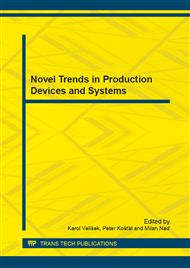p.242
p.249
p.255
p.261
p.267
p.273
p.279
p.285
p.291
Influence of the CAM Parameters and Selection of End-Mill Cutter when Assessing the Resultant Surface Quality in 3D Milling
Abstract:
The paper deals with the effects of CAM data needed to produce desired quality of shaped surfaces in forming dies making. In general, the input CAM data have strong influence to the final surface quality. The shaped surfaces 3D milling has been modeled as end ball milling of the surfaces with defined inclination. The end ball milling is the most common way to finish shaped surfaces. Directions of the milling tools motion and applied cutting conditions have been used to simulate data when setting milling strategies. The resultant machined surface quality has been identified in terms of the surface roughness. The paper introduces recommendations applicable to the programming of the different types of milling strategy when producing form surfaces.
Info:
Periodical:
Pages:
267-272
Citation:
Online since:
January 2014
Authors:
Price:
Сopyright:
© 2014 Trans Tech Publications Ltd. All Rights Reserved
Share:
Citation:


